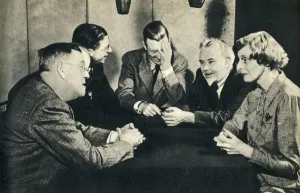Eugenics Collection
"Eugenics: Shaping the World's Destiny through Science and Controversy" In 1886, a French copy of Haeckel's tree of life emerged
All Professionally Made to Order for Quick Shipping
"Eugenics: Shaping the World's Destiny through Science and Controversy" In 1886, a French copy of Haeckel's tree of life emerged, illustrating the intricate interconnectedness of all living beings. This captivating chromolitho depicted nature's diverse tapestry, hinting at the potential for human intervention in shaping future generations. A thought-provoking image from around c1903 showcased an intriguing concept - growing babies from cabbages. While whimsical in nature, it sparked discussions about the possibilities of artificial reproduction and genetic manipulation. The end of the Serbian Dynasty in 1933 marked a turning point in history when eugenics gained prominence as an ideology. Its creator remains unknown but left behind a legacy that would shape societies' perception of selective breeding and population control. During World War II, amidst global turmoil, The Brains Trust convened with Donald McCullough overseas to ponder profound questions. Among them was eugenics – its implications on humanity's future and ethical considerations surrounding scientific advancements. In 1917, Headquarters Nights brought together intellectuals like Vernon Kellogg to discuss eugenic principles aimed at improving society by promoting desirable traits while discouraging unfavorable ones. These conversations fueled debates on how best to achieve societal progress through controlled reproduction. A satirical caricature from 1913 humorously portrayed eugenics as a driving force behind societal dynamics. It highlighted both public fascination and skepticism towards this emerging field that sought to optimize human potential through selective breeding practices. "Eugenics makes the world go round" became a catchphrase encapsulating society's divided opinions on this controversial topic. Advocates argued for its potential benefits while critics raised concerns about discrimination and infringement upon individual rights. Amidst ongoing debates over adoption policies worldwide, eugenics played a role in shaping decisions regarding child placement based on hereditary factors or perceived genetic superiority – raising complex moral dilemmas within society. As science progressed, the concept of designer babies emerged.











